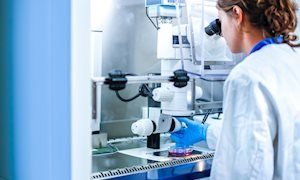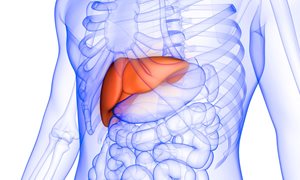 Drilling out a hole in the skull base has to be done with great precision and often takes many hours. It is an intervention that requires the maximum from a surgeon. Researchers from Eindhoven University of Technology (TU/e) have therefore developed a surgery robot to take over this task. With sub-millimeter precision, the robot can automatically and safely mill a cavity of the desired shape and dimensions. Jordan Bos will receive his PhD on 16 April for the robot he designed and built. The robot is expected to perform its first surgery within five years.
Drilling out a hole in the skull base has to be done with great precision and often takes many hours. It is an intervention that requires the maximum from a surgeon. Researchers from Eindhoven University of Technology (TU/e) have therefore developed a surgery robot to take over this task. With sub-millimeter precision, the robot can automatically and safely mill a cavity of the desired shape and dimensions. Jordan Bos will receive his PhD on 16 April for the robot he designed and built. The robot is expected to perform its first surgery within five years.
Studying operations
At the request of ENT doctor and skull base surgeon Dirk Kunst of the Radboud UMC in Nijmegen, Jordan Bos developed a robot to take over at least part of these kinds of operations. He first visited about twenty skull base operations to study these interventions, and then devised about twenty concepts. He created a detailed design of the best concept and built a prototype, which is now ready and with which the first technical tests have already been performed.
Advanced arm
The robot, called RoBoSculpt, works on the basis of precise instructions from the surgeon who accurately indicates which piece of bone the robot has to remove on CT images of the patient's skull. The robot is in fact a very advanced arm, which holds an existing surgical drilling tool. Before the operation, the head is accurately fixed in position and then the robot mills the desired cavity.
Burdensome task
Because the robot works faster in principle, the duration of an operation can be shorter. It is expected that the robot will make more accurate procedures possible, with shorter recovery times, and will result in fewer complications and recovery operations. That would make these kinds of operations less stressful for the patient and potentially less expensive. Surgeons benefit as they are relieved from a burdensome task, which also enables them to keep doing their job when they are older.
Seven axes
The robot is actually an advanced computer-controlled milling machine, or a CNC milling machine, with seven axes of motion to enable all possible angles. Despite the high number of axes, the device is very accurate, thanks to the compactness, the high level of stiffness, the low weight and the minimal backlash on the axes. The robot can also be covered with a sterile cover, which is important in the operating room.
Skull base surgeon Dirk Kunst, who acted as co-supervisor for Bos, is enthusiastic about the robot. "This is an important step towards the operating room of the future. RoBoSculpt is an optimal collaboration between the surgeon and the machine; they really complement each other to achieve the best results for the patient. "
To gain experience
The first pre-clinical tests with the robot will therefore also start this year, at the Radboud UMC. The first operation on people could take place in two to three years. A possible first step in the introduction is that the robot does the preparatory work, and the surgeon himself the crucial final part, in order to gain experience safely with the robot. The company Eindhoven Medical Robotics plans to commercialize the technology, in a partnership with TU/e.
A matter of fixing
A robot that is pre-programmed to perform a surgical procedure is a new development. Nevertheless, Bos does not think that robots will be able to carry out all sorts of other operations in the short term. "The design of this robot is only applicable to precision applications for hard structures in the human body, specifically bones. Soft tissue cannot be fixed with enough precision."
Related news items

Joint research in regional hospitals New research projects from promotion fund
22 November 2022Four research projects have been honored in the promotion fund of the Radboudumc and four regional hospitals. The research projects, which are a collaboration between CWZ, Jeroen Bosch Hospital, Rijnstate, Sint Maartenskliniek and the Radboudumc will receive a contribution of 240,000 euros.
go to page
Liver tumors irradiated from inside can be followed live from outside
17 February 2022 A Dutch research team from Radboud University Medical Center has visualized the injection of radioactive microspheres during treatment of a patient with liver tumors ‘live on screen’. go to page
LUMO Labs and Oost NL invest in Aiosyn Investment accelerates development of artificial intelligence platform to improve diagnostics
7 February 2022 Aiosyn, a spin-off from Radboudumc, has received an investment from LUMO Labs. Oost NL is a co-investor. go to page
Large AI project receives over €95 million for ten years of public-private research
23 September 2021 The Dutch Research Council (NWO) is to fund two consortia for a period of ten years. Radboudumc participates in the ROBUST consortium, which consists of 17 AI labs, eight of which are dedicated to healthcare. Radboudumc leads five of these eight labs. go to page

